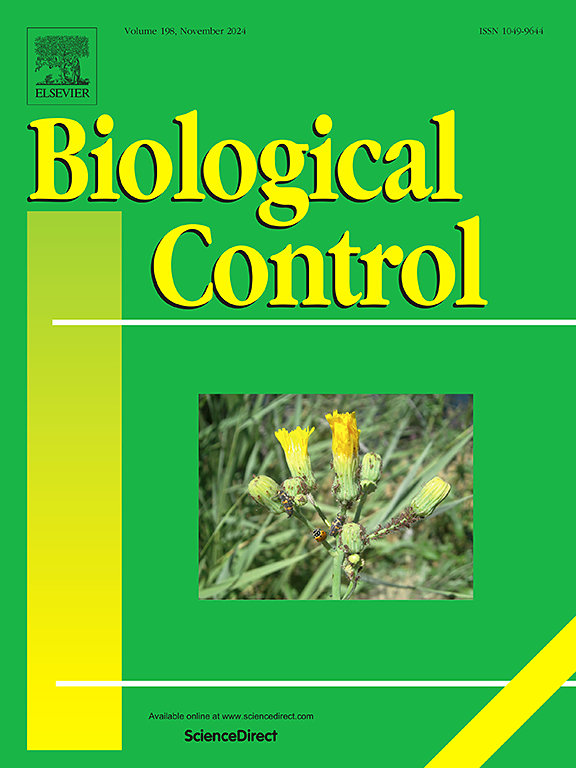尽管微生境热环境存在差异,高温可能会限制巴西胡椒树蓟马(拟蓟马科)在美国的成功繁殖
IF 3.4
2区 农林科学
Q2 BIOTECHNOLOGY & APPLIED MICROBIOLOGY
引用次数: 0
摘要
为了改善美国大陆本土植物群落的保护和恢复,正在对入侵树种——红杉进行生物防治研究。巴西胡椒树蓟马(Pseudophilothrips ichini)的释放和监测正在多个州和气候带进行,但建立情况各不相同。特别是,尽管自2022年以来在四个地点释放了超过15万头蓟马,但在德克萨斯州南部炎热地区的建立尚未得到证实。为了了解在某些地区,热限制是否会阻碍棘球虫草的利用,我们调查了棘球虫草的热上限和下限。在温度和暴露时间多种组合条件下,在实验室测量了寒害区上限(ULCIZ)和热害区下限(LLTIZ),并基于20多年来的详细气象数据模拟了生存的空间变化。此外,我们记录了德克萨斯州南部三个放养点的微栖息地极端温度变化,以评估微栖息地条件变化是否存在热避难所。基于LLTIZ和ULCIZ,温度高于33.08±0.15°C时,热损伤积累迅速,温度低于7.85±0.82°C时,热损伤积累缓慢。大田林冠内温度变化很大,产生了一系列预测的死亡率,在夏季和冬季,树底温度都比较适中。我们确定,基于目前在美国的分布,美国各州的气候适宜性不同。佛罗里达州地点的适宜性被认为是高度到中度适合跨季节,但大多数德克萨斯州地点不适合,包括以前在德克萨斯州南部的发布地点。这些发现表明,佛罗里达大部分地区、南加州地区以及德克萨斯州北部海湾沿岸的一些地区应该会继续释放。此外,在温和季节增加放放量可能为在德克萨斯州使用这种生物防治剂管理特雷宾提佛兰提供了机会。本文章由计算机程序翻译,如有差异,请以英文原文为准。
High temperatures will likely limit establishment success of the Brazilian peppertree thrips, Pseudophilothrips ichini (Thysanoptera: Phlaeothripidae) in the USA, despite variation in microhabitat thermal environments
Biological control of the invasive tree, Schinus terebinthifolia Raddi, is under investigation to improve conservation and restoration of native plant communities in the continental USA. Release and monitoring of the Brazilian peppertree thrips, Pseudophilothrips ichini, is ongoing in multiple states and climate zones but establishment has been variable. In particular, establishment has not been confirmed in hot, southern Texas locations despite release of over 150,000 thrips across four locations since 2022. To understand whether thermal limitations may preclude use of P. ichini in some regions, we investigated upper and lower thermal limits of P. ichini. We measured upper limit of chill injury zone (ULCIZ) and lower limit of thermal injury zone (LLTIZ) in the laboratory under multiple combinations of temperature and exposure duration then modeled spatial variation in survival based on detailed weather data over 20 years. Additionally, we documented microhabitat variation in temperature extremes in three release sites in south Texas to evaluate whether thermal refugia exist due to variation in microhabitat conditions. Based on LLTIZ and ULCIZ, thermal injury accumulates rapidly at temperatures above 33.08 ± 0.15 °C and more slowly at decreasing temperatures below 7.85 ± 0.82 °C. Temperatures within the canopy of S. terebinthifolia in the field varied widely and produced a range of predicted mortality, with temperatures at the base of trees that were more moderate in both summer and winter. We determined that, based on the current distribution of S. terebinthifolia in the USA, climate suitability differs between states. Suitability of Florida locations was deemed highly to moderately suitable across seasons, but most Texas locations were unsuitable, including previous release locations in south Texas. These findings suggest releases should continue through most of Florida, in areas of southern California, and locations along the northern gulf coast of Texas. Additionally, augmentative releases of P. ichini during mild seasons may provide opportunities for use of this biological control agent to manage S. terebinthifolia in Texas.
求助全文
通过发布文献求助,成功后即可免费获取论文全文。
去求助
来源期刊

Biological Control
生物-昆虫学
CiteScore
7.40
自引率
7.10%
发文量
220
审稿时长
63 days
期刊介绍:
Biological control is an environmentally sound and effective means of reducing or mitigating pests and pest effects through the use of natural enemies. The aim of Biological Control is to promote this science and technology through publication of original research articles and reviews of research and theory. The journal devotes a section to reports on biotechnologies dealing with the elucidation and use of genes or gene products for the enhancement of biological control agents.
The journal encompasses biological control of viral, microbial, nematode, insect, mite, weed, and vertebrate pests in agriculture, aquatic, forest, natural resource, stored product, and urban environments. Biological control of arthropod pests of human and domestic animals is also included. Ecological, molecular, and biotechnological approaches to the understanding of biological control are welcome.
 求助内容:
求助内容: 应助结果提醒方式:
应助结果提醒方式:


